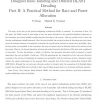Free Online Productivity Tools
i2Speak
i2Symbol
i2OCR
iTex2Img
iWeb2Print
iWeb2Shot
i2Type
iPdf2Split
iPdf2Merge
i2Bopomofo
i2Arabic
i2Style
i2Image
i2PDF
iLatex2Rtf
Sci2ools
TWC
2008
2008
Spatial Multiplexing Architectures with Jointly Designed Rate-Tailoring and Ordered BLAST Decoding - Part II: A Practical Method
The study of the class of new spatial multiplexing architectures (SMAs) is continued. As introduced in Part I of this paper, the SMAs consist of joint design of rate and power allocation to the spatially-multiplexed substreams at the transmitter and ordered nulling/canceling detection/decoding at the receiver. This was studied in Part I under the diversity-multiplexing tradeoff framework. Here the more detailed and practical problem of allocating rates and powers across the transmit antennas is investigated to minimize the overall system (uncoded or outage) error probability. Since the layer gains are unavailable to the transmitter, the rates and powers must be allocated based on the statistics of the layer gains. However, the channel dependent ordering rules make the precise distributions of the layer gains complicated or intractable. To solve this problem, a simple, yet effective, four-parameter hyperbola model is proposed to closely approximate the error probability of each layer. ...
| Added | 16 Dec 2010 |
| Updated | 16 Dec 2010 |
| Type | Journal |
| Year | 2008 |
| Where | TWC |
| Authors | Yi Jiang, Mahesh K. Varanasi |
Comments (0)

